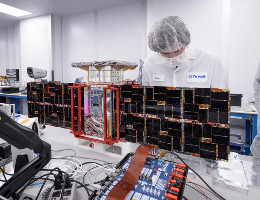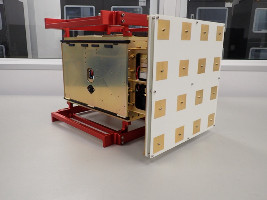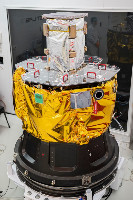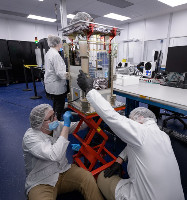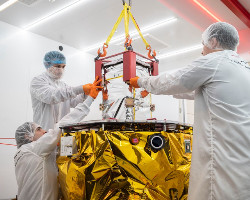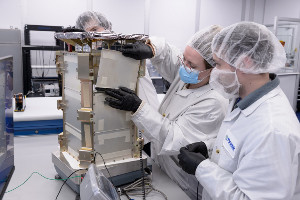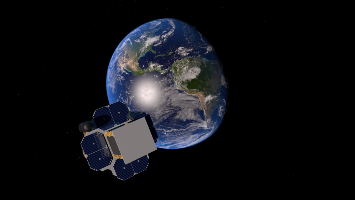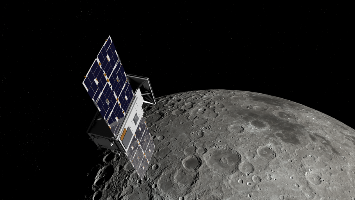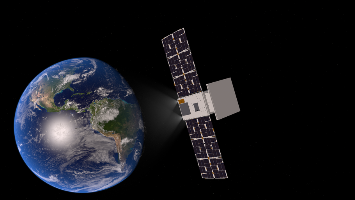| Satellite | CAPSTONE (Cislunar Autonomous Positioning System Technology Operations and Navigation Experiment) |
|---|---|
| Spacecraft type | CubeSat |
| Units or mass | 12U |
| Status | Operational (There have been challenges but latest press releases and news have been positive as of 2024-12-23) |
| Launched | 2022-06-28 |
| NORAD ID | 52914 |
| Deployer | Custom |
| Launcher | Electron |
| Entity name | NASA Ames Research Center |
| Institution | Space agency |
| Entity type | Government (Civil / Military) |
| Headquarters | US |
| Manufacturer | AIVT by Terran Orbital |
| Oneliner |
Demonstrate spacecraft-to-spacecraft navigation and enter Lunar near-reactilinear halo orbit to verify its feasibility for the Gateway lunar orbiting outpost. |
| Description |
Designed to go into a near-rectilinear halo orbit around the Earth to closely match the Moon's orbit. The primary objectives are to demonstrate spacecraft-to-spacecraft navigation and to enter this orbit to verify its feasibility, to gain experience for future flights planning to use similar orbits, and as a precursor to the possible Gateway lunar orbiting outpost. A deployable dish antenna is used for communication. Propulsion is provided by a monopropellant hydrazine reaction control system. It uses eight 0.25 N thrusters, four for translational thrust and four for rotational thrust. It will carry approximately 3.2 kg of hydrazine in a machined aluminum tank. It will be launched on a Rocket Lab Electron booster from NASA Wallops Flight Facility into a 250 km circular Earth orbit, the Photon upper stage will perform a series of orbit-raising maneuvers to put CAPSTONE into a trans-lunar trajectory. CAPSTONE will travel 3 months under its own propulsion. It will then enter a near-rectilinear halo orbit, in which the spacecraft orbits the Earth along with the Moon, and will come within about 1600 km of one pole and then 7 days later pass roughly 70,000 km above the other pole. It will continue in this orbit for at least six months, testing communications with the Lunar Reconnaissance Orbiter (LRO), already in orbit around the Moon, and ground stations on Earth. It will also use data from communications with LRO to determine its position. The orbit, formally known as a near rectilinear halo orbit (NRHO), is significantly elongated. Its location at a precise balance point in the gravities of Earth and the Moon, offers stability for long-term missions like Gateway and requires minimal energy to maintain. CAPSTONE’s orbit also establishes a location that is an ideal staging area for missions to the Moon and beyond. To test these new navigation capabilities, CAPSTONE has a second dedicated payload flight computer and radio that will perform calculations to determine where the CubeSat is in its orbital path. Circling the Moon since 2009, NASA’s Lunar Reconnaissance Orbiter (LRO) will serve as a reference point for CAPSTONE. The intention is for CAPSTONE to communicate directly with LRO and utilize the data obtained from this crosslink to measure how far it is from LRO and how fast the distance between the two changes, which in turn determines CAPSTONE’s position in space. This peer-to-peer information will be used to evaluate CAPSTONE’s autonomous navigation software. If successful, this software, referred to as the Cislunar Autonomous Positioning System (CAPS), will allow future spacecraft to determine their location without having to rely exclusively on tracking from Earth. This capability could enable future technology demonstrations to perform on their own without support from the ground and allow ground-based antennas to prioritize valuable science data over more routine operational tracking. Mission objectives:
|
| Results |
CAPSTONE has successfully operated in the NRHO since 11/13/22 (167 days)
CAPSTONE working well more than a year after launch (SpaceNews, 2023-07-24)
CAPSTONE™ To Host Additional Experiments to Support Technology Shortfalls for Cislunar Space, 2025-04-02.
|
| Notes |
CAPSTONE is not a standard 12U CubeSat as per specifications and instead a microsatellite due to fixed protruding antenna. Making an expection by including it. Launch moved from Virginia, US to New Zealand. |
| Sources | [1] [2] [3] [4] [5] [6] [7] [8] [9] [10] [11] [12] [13] [14] [15] [16] [17] [18] [19] [20] [21] [22] [23] [24] [25] [26] |
| Photo sources | [1] [2] [3] [4] [5] [6] [7] [8] [9] |
| COTS subsystems |
|
| Subsystems sources | [1] |
| Keywords | Beyond Earth orbit, Beyond LEO orbit, Propulsion |
Last modified: 2025-04-14
